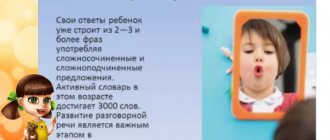Sensitive period for the development of social skills
At the age of 2.5 to 6 years, the child begins to take an active interest in forms of polite behavior.
This is the time when a child needs to be helped to learn cultural forms of communication so that he feels confident being around a wide variety of people.
The sensitive period is a limited period of time during which a person is more receptive to specific signals than during other periods of life.
As you can see, it's actually nothing complicated. You yourself intuitively felt and knew all this. It’s just that now you have confirmation that you are doing everything right, because you are watching your child and letting him develop according to his nature.
Periodization according to A. N. Leontiev
A. N. Leontyev identified 4 main stages of speech development in ontogenesis, which begin at birth and cover the school years. A brief description of them is presented below.
Preparatory stage
In the period from birth to one year, the prerequisites are created for mastering the components of the language system. The first vocal reactions are screaming and crying, which contribute to the development of the respiratory, vocal and articulatory departments.
At the age of several weeks, the baby begins to listen to the voices of the people around him and respond to them. By the end of the 1st month, he already calms down when he hears a lullaby. In the first months, a revival complex appears: a smile, motor movements of the limbs in response to the appearance of relatives. A reaction to the intonation of an adult appears.
At 2 months, humming appears, and by 3-4 months the babbling stage begins. From 5 months, the child tries to repeat the articulation of adults. From 6 months, syllables appear in speech. By imitating, the baby masters all the basic elements of the prosodic side of speech.
In the period from 6 months to one year, the child distinguishes certain sound combinations and compares them with objects or actions. Gradually, the baby repeats increasingly complex combinations of sounds after those around him. The end of the period is marked by the appearance of the first words and the activation of the communicative function of speech. At this time, it is very important for parents to create favorable conditions for the child to master the language system.
Developmental stage up to three years
Between one and three years of age, children pay special attention to the articulation of those around them. The child repeats after adults and tries to pronounce increasingly complex words. In his speech, phoneme mixtures, substitutions, and distortions occur due to the correct articulatory patterns that have not been formed due to age.
From one to 1.5 years, children's speech is situational (contextual) in nature. Understanding what a child wants can only be done by taking into account the situation. The baby actively uses non-verbal means of communication. Starting from 1.5 years, speech acquires a more generalizing orientation. He begins to understand adults' instructions. From 2 to 3, there is an active accumulation of vocabulary.
By the beginning of the 3rd year of life, simple grammatical categories are mastered. There is a transition from monosyllabic statements to simple phrases with violated agreement norms. Gradually, the child masters the skill of grammatically connecting words in a sentence. By the age of two, he has almost completely mastered the categories of singular and plural; case endings appear. Speech understanding is ahead of the child's pronunciation capabilities.
Preschool development period
In many children, sound pronunciation is distorted because the articulation organs are not yet ready for complex structures. Improves the skill of self-control over your speech and those around you; phonetic-phonemic processes are formed.
Vocabulary continues to grow, with children using approximately 3,000–4,000 words by ages 4–6. The meaning of words is clarified, but sometimes they are used in a way that does not correspond to their meaning. At the age of 4-5 years, the phenomenon of word creation occurs, during which the formation of a linguistic sense occurs.
Grammatical structure and coherent speech develop. Proposals become more complex and more widespread. At 4 years old, complex sentence structures predominate in children's speech. At the age of 5 years, sentences are composed taking into account the grammatical connections of words. Children's answers are like a short story. Mastery of the monologue form of speech begins; the preschooler can retell short fairy tales without the help of adults.
By the end of the preschool period, correct sound pronunciation, phonetic-phonemic processes and contextual speech are fully formed.
School period
Its duration is from 7 to 17 years. A distinctive feature is the conscious acquisition of speech. The skill of sound analysis and the grammatical rules of the native language are mastered. The main role is given to written speech. The child learns to consciously use acquired speech skills.
Sensitive period of speech development
Lasts on average from 0 to 6 years.
Under one year of age:
Children learn to imitate sounds.
Around 1 year of age:
The baby consciously pronounces the first word; for the first time in his life there is a verbal expression of thought.
At about 1.5 years of age:
The baby begins to express his feelings and desires. It is important to understand that the child is able to perceive the grammatical norms of the language and is able to formulate a sentence grammatically accurately.
What does it mean?
At the age of 2.5 - 3 years
The baby often talks to himself. This is an opportunity to eavesdrop on his thoughts, see the logic or illogicality of thinking in them.
At the age of 3.5 - 4 years
: the child actively expands his vocabulary, enjoys talking, composing and telling stories.
Recommendation:
With a child, there is no need to lisp and simplify the language to “childish”. On the contrary, he needs to be introduced to the richness of his native language, its diversity.
Children of this age are keenly interested in the symbolic designation of sounds - letters, enthusiastically trace letters from rough paper, etc.
Therefore, at the age of 4.5 - 5 years
It seems completely natural that the child begins to write individual words and numbers of his own free will and tries to write his name.
Finally, at about 6 years
the child is ready and wants to learn to read.
If a child has to do something outside the framework of the corresponding sensitive period, that is, under duress (learn to read, write, etc.), then he comes to the result later or does not come at all.
Sensitive period of perception of order.
This sensitive period is not described in detail anywhere except in the works of Maria Montessori: “The true essence of the mind is to give order to the chaotic impressions emanating from the surrounding world.”
This period lasts from 0 to 3 years, and the stage of its highest intensity occurs around 2 - 2.5 years.
“For a child, order is the same as for us the floor on which we walk, and for a fish the water in which it swims. In early childhood, the human spirit takes from the surrounding world the orienting elements that are needed for subsequent mastery of the surrounding world,” wrote Maria Montessori.
It is very important that the life of a child aged 0 to 3 years be accompanied by an external routine. His inner peace in later life—order in his thoughts and actions—depends on how orderly the environment is during this period.
Montessori emphasizes that at the age of 2 - 2.5 years the child experiences a characteristic love, or rather, a real passion for maintaining the order that is familiar to him. He needs everything to be repeated and predictable in his home, in his daily routine and in the behavior of adults towards him.
Sensitive period for the perception of small objects
Lasts on average from 1.5 to 2.5 years.
The child is drawn to small objects; he likes to play with buttons, peas, and cereals. Why? Because he begins to realize that the world consists of small parts. Here was a cup and now it broke into small pieces, and those can break into even smaller ones. During this period, the parents’ task is to direct the child’s activities in the right direction and provide him with a safe opportunity (under supervision) to operate with small objects: string beads on threads and laces, sort through cereals, make appliqués from buttons, etc.








